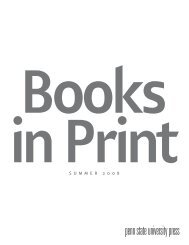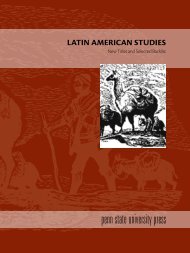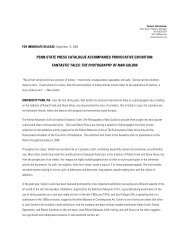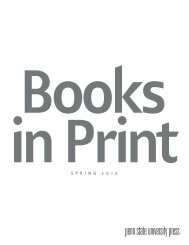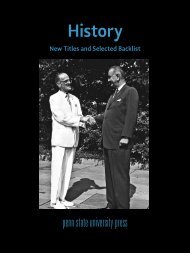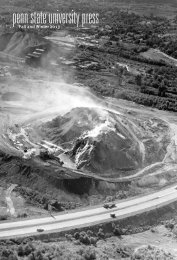Download the Catalog (PDF) - Pennsylvania State University Press
Download the Catalog (PDF) - Pennsylvania State University Press
Download the Catalog (PDF) - Pennsylvania State University Press
You also want an ePaper? Increase the reach of your titles
YUMPU automatically turns print PDFs into web optimized ePapers that Google loves.
Barbara Groseclose is Professor andGraduate Chair in <strong>the</strong> Department of<strong>the</strong> History of Art at Ohio <strong>State</strong> <strong>University</strong>.She was a Distinguished Chairof American Studies in Utrecht (1994)and in Florence (2001) and a VisitingResearch Fellow at <strong>the</strong> <strong>University</strong> of Oxford(2006). Her major publications areNineteenth-Century American Art (2000)and British Sculpture and <strong>the</strong> CompanyRaj (1995).Jochen Wierich is Curator of Art atCheekwood Botanical Garden and Museumof Art. He has published articlesin such periodicals as Winterthur Portfolio,American Art, American StudiesInternational, and Film and History. Heis a contributing author to a number ofexhibition catalogues, including NewWorld: Creating an American Art (2007)and The Eight and American Modernisms(2009).Jacket illustration: Banner advertising “I LikeAmerica: Fictions of <strong>the</strong> Wild West” exhibitionat <strong>the</strong> Schirn Kunsthalle Frankfurt(photo: Jochen Wierich).Internationalizing <strong>the</strong> Historyof American ArtViews28 | penn state pressEdited by Barbara Grosecloseand Jochen WierichContributorsNew in Paperbackderrick r. cartwrightbarbara grosecloseserge guilbautAmerican art historydavid petersis a remarkablycorbettyoung, but rapidlygrowing, discipline. Membership in <strong>the</strong> Associa-andrew hemingwaytion of Historians of American Art, founded in 1979,sophie levychristin j. mamiyanow totals nearly 600. As a result of this growth, geo-marylin mckaygraphical and cultural borders no longer contain <strong>the</strong>veerle thielemansfield. American art history jochen wierich has become “international-rebecca zurierized,” represented by scholars and exhibitions around<strong>the</strong> globe. While this international transmission andexchange of ideas will certainly prove to be valuable,<strong>the</strong> pennsylvania state university pressit has been left largelyuniversityunexamined.park, pennsylvaniaInternationalizingwww.psupress.org<strong>the</strong> History of American isbn: 978-0-271-03200-9 Art begins a critical examinationof this exchange, showing how it has becomepart of <strong>the</strong> maturation of American art history.In this volume, a distinguished group of scholarsconsiders <strong>the</strong> shaping and dissemination of <strong>the</strong>history of American art domestically and internationally,past and present, <strong>the</strong>oretically andpractically, from a variety of intellectual positionsand experiences. This examination indicates adirection for <strong>the</strong> field and a future historiographythat is shaped by international dialogue.256 pages | 15 illustrations | 7 x 10 | 2009isbn 978-0-271-03200-9 | cloth: $70.00 shisbn 978-0-271-03088-3 | paper: $35.00 shgrosecloseandwierichInternatIonalIzIng <strong>the</strong> hIstoryof amerIcan artviewspennstatepress(continued from front flap)Illustrated with more than 130 full-colorimages, <strong>the</strong> text will appeal to localhistorians, scholars of printing history, andthose studying visual and popular culture,advertising, and economic history. Thedepicted advertisements, cityscape and bird’seyeviews, disaster prints, and zoologicalillustrations document Philadelphia whileshowcasing <strong>the</strong> skilled work of <strong>the</strong> city’slithographers. Philadelphia on Stone highlights<strong>the</strong> finesse and allure of <strong>the</strong> lithographicprocess, which radically altered <strong>the</strong> visuallandscape of Philadelphia and <strong>the</strong> country.InternatIonalIzIng <strong>the</strong> hIstoryof amerIcan artAside from <strong>the</strong> editor, <strong>the</strong> contributors includeJennifer Ambrose, Donald H. Cresswell, Sara W.Duke, Christopher W. Lane, Michael Twyman,Dell Upton, and Sarah J. Wea<strong>the</strong>rwax.erika piola is Associate Curator of Printsand Photographs at <strong>the</strong> Library Company ofPhiladelphia.viewsedited bybarbara grosecloseandjochen wierich“The Philadelphia on Stone project and thisaccompanying volume move <strong>the</strong> topic oflithography in Philadelphia forward in importantways, connecting business history, labor history, and<strong>the</strong> consumption of prints to form a new basis forunderstanding <strong>the</strong> medium’s contributions to visualculture.”—helena wright,author of Prints at <strong>the</strong> Smithsonian“Philadelphia on Stone is a sumptuously illustratedbook that brings new discoveries and freshperspectives to <strong>the</strong> cultural history of Philadelphia.This broadly contextualized examination of printingexpands our understanding of <strong>the</strong> production andconsumption of visual culture in a major urbancenter.”—anne verplanck, Penn <strong>State</strong> HarrisburgCo-published with <strong>the</strong> Library Company of Philadelphia<strong>the</strong> pennsylvania state university pressuniversity park, pennsylvaniawww.psupress.orgJacket illustration: John Caspar Wild, Panorama of Philadelphiafrom <strong>the</strong> <strong>State</strong> House Steeple (Philadelphia: Wild & Chevalier,1838), detail. Lithograph. Library Company of Philadelphia.“Here,we import everything.Laws, ideas, philosophies,<strong>the</strong>ories, subjects of conversation,aes<strong>the</strong>tics, sciences, style,industries, fashions, mannerisms,jokes, everything comes inboxes on <strong>the</strong> boat.”—João da EgaAmerican art history is a remarkably young,but rapidly growing, discipline. Membershipin <strong>the</strong> Association of Historians of“Philadelphia on Stone demonstrates very clearly <strong>the</strong>key role American that Philadelphia Art, founded played in in <strong>the</strong> 1979, history now of totalsAmerican lithography in <strong>the</strong> nineteenth century.nearly 600. As a result of this growth, geographicalstory that and encompasses cultural borders many different no longerThe eight essays interweave to tell a complex andcompellingaspects of <strong>the</strong> nineteenth-century lithographiccontain <strong>the</strong> field. American art history hasprinting trade: landscape prints and city views,portraits, become prints “internationalized,” that depict sensational news represented events, byillustrations for books and periodicals, and a vastpanoplyscholarsof advertisingand exhibitionswork. The biographicalaround <strong>the</strong>essaysglobe.on <strong>the</strong> While artist James this Queen international and <strong>the</strong> lithographer transmission andand publisher Peter S. Duval bring to life two menof extraordinary exchange talent of ideas who were will certainly responsible prove for to bePhiladelphia’s valuable, unique it has contribution been left to <strong>the</strong> largely evolution unexamined.Internationalizing have to say about lithography <strong>the</strong> History in of Ameri-of lithography. Much of what Erika Piola andher colleaguesPhiladelphia can Art is begins equally true a critical of lithography examination as it of thisdeveloped in o<strong>the</strong>r cities across <strong>the</strong> nation, and sothis book, exchange, which sets showing out to recount how it what has happened become partin a specific of <strong>the</strong> place, maturation comes very of close American to being art a history.comprehensive history of lithography in America asa whole. It is sure to become a classic.”—nancy In finlay, this volume, Curator of a Graphics, distinguished The Connecticut group ofHistorical Societyscholars considers <strong>the</strong> shaping and disseminationof <strong>the</strong> history of American art domesticallyand internationally, past and present,<strong>the</strong>oretically and practically, from a varietyof intellectual positions and experiences. Todo so, <strong>the</strong>y draw on a literature that, collectively,constitutes a bibliography for <strong>the</strong> fu-isbn ISBN 978-0-271-05252-6ture of <strong>the</strong> field. Three sections—“AmericanArt and Art History,” “Display and Exposition,”and “Post-1945 Investments”—provide<strong>the</strong> structure in which <strong>the</strong> contributorsexamine <strong>the</strong> existing narrative frameworkfor <strong>the</strong> history of American art. This examinationindicates a direction for <strong>the</strong> field anda future historiography that is shaped by internationaldialogue.piolaphiladelphia on stone C O M M E R C I A L L I T H O G R A P H YIN PHILADELPHIA, 1828–1878pennstatepressC O M M E R C I A LL I T H O G R A P H Yedited by erika piola“this is <strong>the</strong>mysteryof <strong>the</strong> art,which to <strong>the</strong>artist is nomystery atall, but aplain matterof rule, asdefinitelyfixed asgeometrycan make it.”I N P H I L A D E L P H I A,1828–1878— Public Ledger,July 1, 1853Philadelphia on StoneCommercial Lithography in Philadelphia,1828–1878Edited by Erika Piolacommerciallithographyon stonein philadelphia1828–1878“The Philadelphia on Stone project and this accompanyingvolume move <strong>the</strong> topic of lithographyPhiladelphia on Stone is <strong>the</strong> first work inover fifty years to examine <strong>the</strong> history ofnineteenth-century commercial lithographyin Philadelphia. The capstone to <strong>the</strong> LibraryCompany of Philadelphia’s multifacetedPhiladelphia on Stone project, this heavilyillustrated volume of <strong>the</strong>matic essays providesan analysis of <strong>the</strong> social, economic, andtechnological changes in <strong>the</strong> local tradefrom 1828 to 1878; biographies of premierlithographers P. S. Duval and James Queen;culture.”and new insights about genres of lithographspertaining to book illustration, advertising,sensational news, and landscape imagery.in Philadelphia forward in important ways, connectingbusiness history, labor history, and <strong>the</strong>consumption of prints to form a new basis for understanding<strong>the</strong> medium’s contributions to visual—Helena Wright,author of Prints at <strong>the</strong> Smithsonian(continued on back flap)“Philadelphia on Stone demonstrates very clearly <strong>the</strong>key role that Philadelphia played in <strong>the</strong> history ofAmerican lithography in <strong>the</strong> nineteenth century.The eight essays interweave to tell a complex andcompelling story that encompasses many differentaspects of <strong>the</strong> nineteenth-century lithographicprinting trade: landscape prints and city views, portraits,prints that depict sensational news events,illustrations for books and periodicals, and a vastpanoply of advertising work. . . . Much of whatErika Piola and her colleagues have to say aboutlithography in Philadelphia is equally true of lithographyas it developed in o<strong>the</strong>r cities across <strong>the</strong>nation, and so this book, which sets out to recountwhat happened in a specific place, comes very closeto being a comprehensive history of lithography inAmerica as a whole. It is sure to become a classic.”—Nancy Finlay, Curator of Graphics,The Connecticut Historical Society320 pages | 134 color illustrations | 9 x 10 | 2012isbn 978-0-271-05252-6 | cloth: $49.95 shCo-published with <strong>the</strong> Library Company of Philadelphiawww.psupress.org | 29



